Hunger. Humiliation. Excessive work and sexual abuse. All this awaited Polish women who were forced to go to Nazi Germany during the war. Will we ever find out what the real scale of this phenomenon was?
Hitler's plan to exploit and then exterminate the Polish population did not provide for any exceptions. The brutal actions involved everyone, including women and children.
This was confirmed by Hitler himself, who in the famous speech to the generals, delivered just before the attack on Poland, stated that he had sent SS troops to the East with the order "to kill without mercy and pardon all men, women and children of the Polish race and language" . It was impossible to express myself more clearly:Polish women could not count on pity ...
Torn from the family home
First, it was intended to use Poles and Polish women as labor. Even during the September campaign, the Germans began recruiting them to work in agriculture and industry. When it turned out that the voluntary recruitment did not bring the desired results, they resorted to coercion. People were designated administratively or simply caught in street round-ups.
It is worth adding that this group was dominated by the fair sex. According to Sophie Hodorowicz Knab, author of the book "Marked with the letter P. Polish women as forced laborers in the Third Reich 1939-1945", "more than half of the Polish civilian forced laborers in Germany were women - the average age was around 20".
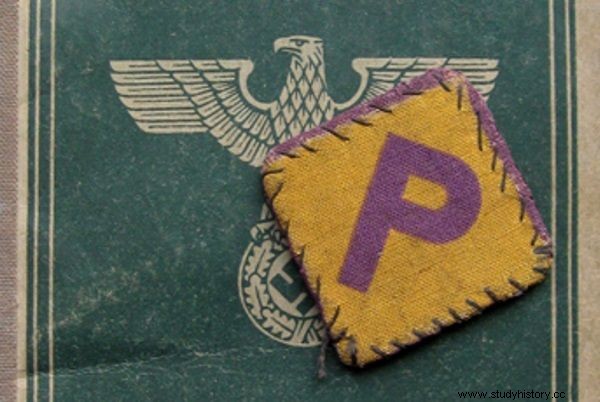
Polish women forced to work in the Third Reich received special patches that distinguished them from the German population.
The very process of "recruitment" gave a taste of what awaited young Polish women in the Reich. It happened that German gendarmes entered the houses at night and took designated people, giving them only a few moments to pack up and say goodbye . Others were captured in the streets, churches or cinemas. As Alicja Strojnowska from Legionowo recalled:
The sight of the Germans standing on the railway track convinced us that it was a manhunt. There was no question of escaping. Half an hour later they came and pulled us out of the house. The crying of my brother and the plea of my mother did not help. The Father and me were taken. When I was leaving I looked at Wiesio [my brother - editor's note]. PS] - we were not allowed to say goodbye. To this day, I can still see the scene in which he was standing in a crib in a T-shirt and crying, begging us not to be taken away.
Treating women captured in this way was just as far from delicacy. This is how Mieczysław Kałówńska-Radosz remembers the stay at the collection point, who was sent to work in 1942:
I found myself in a large hall among strangers, in a crowd of companions in misery. After an hour, we were told to undress and go to the bathhouse. Our protests only caused laughter from the Germans, who were lining this women's tumult. "All of you Poles, you are dirty, you have lice, you need to bathe."
It outraged me, I couldn't stand it, I spoke up in defense of the word "Poles", so dear to me at the moment - and I was punched in the face. So I found myself naked among a crowd of naked women in the bathhouse, where the showers first ran hot, then ice-cold water. It caused the general laughter of the escort guarding us. Then everyone had their long hair cut .
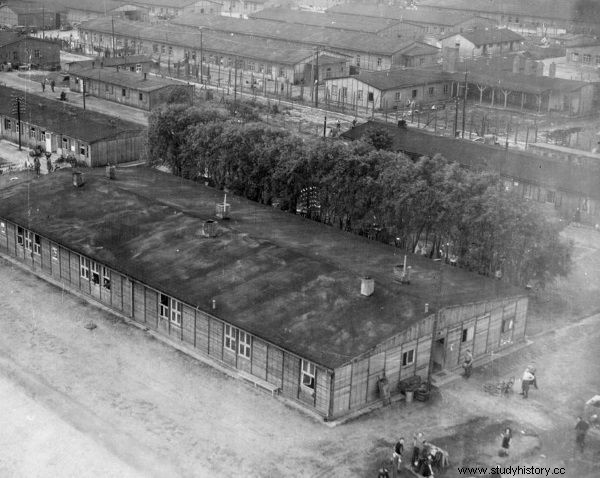
Polish women often forced to work in chemical factories producing ammunition.
The transit camps to which Polish women were sent were usually dirty, unheated, without an adequate number of toilets, and sometimes even without toilets at all. There were also no places to sleep. The women were given small portions of food. They were handled brutally and with contempt. Sophie Hodorowicz Knab quotes the shocking account of Janina Dębicka-Malińska, who was sent to the camp in Krakow:
[…] we were with highlander girls of extraordinary beauty. Two of them went mad, wailing screaming and lamenting, tearing their hair out . The Germans took them immediately. I don't know what happened to them afterwards .
Slave market
Transport to the Reich usually took place in cattle cars, dirty and cold. They were closed from the outside to prevent escape. On the way, the women were rarely given water and food. After arriving at the place, their selection took place. The interested "employers" - farmers, factory directors, workshop owners - selected the workers according to their needs, usually young and strong.
The procedure was like a slave market. Some groped the presented women to see if they were fit for physical labor. They looked at their teeth and hair . Sometimes there were even arguments about one of the employees. During the selection, there were also dramatic scenes when officials separated mother from daughter, wife from husband, sister from brother.
Most of the Polish women sent to work were sent to work in agriculture. Initially, it was about 90 percent of them, then about 70 percent. Women were "employed" in larger and smaller private farms. The conditions there depended on the host, but they were usually difficult. The work took all day and was often overwhelming.

The Germans placed Poles in transit camps before deportation. Conditions were difficult in them. It wasn't much better in place. Illustrative photo.
They were fed poorly and discipline was strict. Often there were owners-sadists who treated their Polish female employees exceptionally cruelly. For example, Janina Suchowa was punished only because ... she forgot to cook milk for the host. "He hit me so in the face that I fainted on the spot, he beat me, cursing very much that he would kill all Poles' dogs" - he recalls.
Employers de facto they could do whatever they wanted with the forced laborers. The parties were not bound by any agreement, so nothing stood in the way of forcing Poles to work for a whole week, starving, humiliating, or even lowering the already low salary. As reported in her book by Sophie Hodorowicz Knab, an open consent to such activities was even included in one of the circulars sent by the administration to the bauers. It was reported there that Polish workers were to work as many hours a day as required by the needs of a given farmer, and that the hours of their work should not be limited under any circumstances.
In practice, therefore, the women brought from the Commonwealth started their working day before dawn and ended well after sunset. They worked in tillage and on the farm, fed the animals, and operated agricultural machinery. As one of the workers recalls:
I got up before sunrise to milk eight cows. Other homework, with pigs, poultry, until 7 o'clock, breakfast, and the field. They had 120 morga. There was then a beetroot work:weeding, digging. (...) You couldn't straighten your neck, raise your head, look at the sky ...
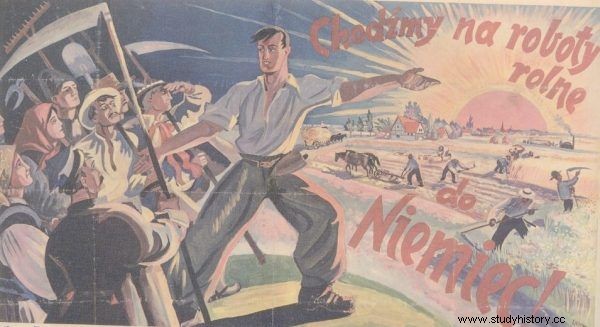
A significant number of Polish women worked on German farms.
To the hardships associated with the work itself, sometimes horrible living conditions were added. Polish women were poorly fed. They were ordered to sleep in various strange places - barns, cowsheds, garages, attics, often cold, dirty and infested. At times, they shared the roof over their heads with farm animals. They had no medical care, which resulted in illness with their exhausting lifestyle.
To make matters worse, the hosts willingly took advantage of the advantage they had over the young girls and sexually abused them. The scale of this phenomenon is still unknown and is still waiting to be thoroughly investigated. There are many indications, however, that it was universal. Sophie Hodorowicz Knab cites many such dramatic cases in her book. Also, pregnancies, as you can guess, were not uncommon. A Polish woman who was expecting a child with a German was allowed to give birth and feed her for four weeks. Then they were collected and placed in a German family, where they were subjected to Germanization.
Hands burned and blistered
The situation of Polish women sent to work in industry was equally difficult. Workers lived in barracks in special camps, the condition of which was sometimes deplorable. There was often a lack of heating, an adequate number of toilets or washrooms. As the number of female workers grew, stranger places began to be used for accommodation, such as ruined barracks, old forts or decommissioned ships.
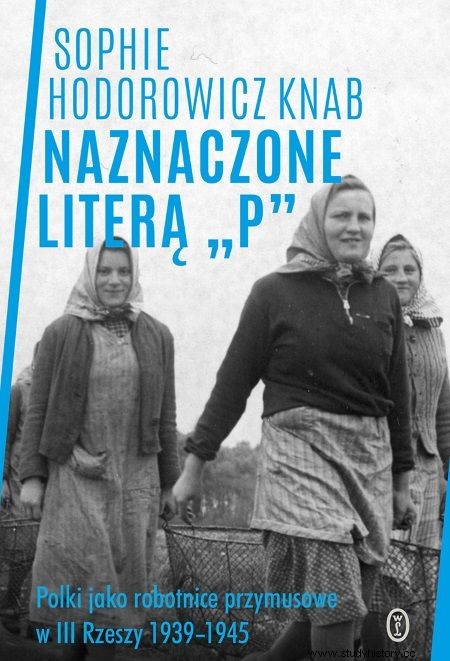
You can find out more about the fate of Polish women deported to Germany during World War II by reading the book by Sophie Hodorowicz Knab entitled “Marked by the letter P” (Wydawnictwo Literackie, 2018).
In addition, surveillance and rigor in industry were much greater than in the countryside. The length of the working day varied depending on the type of plant, but it happened that Polish workers had to spend 10-12 hours a day in the factory. Their activities were also often dangerous or dangerous to health. "I had to get the hot water bullets and throw them on the conveyor belt. My hands were burned and blistered forever ” - one of them recalled.
Many Polish women employed in chemical plants or ammunition factories were forced to work with corrosive materials. They often stayed in rooms with polluted air. It was not difficult to find accidents. They were also accompanied by harassment from German supervisors, foremen and workers. And when the Allied air raids on Germany began, to all these inconveniences there was also the risk of death by bombing.
It should also not be forgotten that women were plagued by hunger, fear and longing for their loved ones at every step. They spent months and even years in exile. How many were there? It is estimated that during the war over 2 million 800 thousand people were deported from the Polish lands for forced labor ...
Horror in the camps
However, Polish women who ended up in forced labor could still speak of happiness. Those sent to concentration camps in the Reich were much worse. The worst fame was achieved by KL Ravensbrück, founded in 1938. It was intended for women. Political prisoners were sent to him, including citizens of the Republic of Poland. The latter soon made up the majority of inmates.
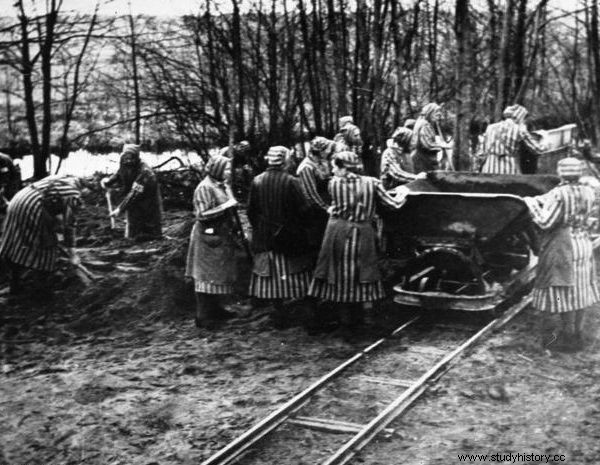
The worst fame was achieved by KL Ravensbrück, established in 1938. It was intended only for women.
Nazis conducted pseudo-medical experiments on the women in the camp . For example, they had their tibia transplanted from left to right and vice versa. Such operations were performed on 74 Polish women. Many of those who survived became crippled. Another horrible experience was the referral to the camp brothel. Such institutions existed in 10 concentration camps and prisoners from the Vistula River also ended up in them.
As Sophie Hodorowicz Knab writes, the experiences of the war burdened the psyche of most of the women who ended up in the Reich during the war. They had to deal with the trauma for the rest of their lives.
